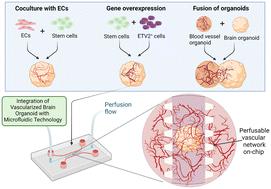Our official English website, www.x-mol.net, welcomes your
feedback! (Note: you will need to create a separate account there.)
Vascularized human brain organoid on-chip
Lab on a Chip ( IF 6.1 ) Pub Date : 2023-05-31 , DOI: 10.1039/d2lc01109c Sin Yen Tan 1 , Xiaohan Feng 1 , Lily Kwan Wai Cheng 2 , Angela Ruohao Wu 1, 2, 3, 4, 5
Lab on a Chip ( IF 6.1 ) Pub Date : 2023-05-31 , DOI: 10.1039/d2lc01109c Sin Yen Tan 1 , Xiaohan Feng 1 , Lily Kwan Wai Cheng 2 , Angela Ruohao Wu 1, 2, 3, 4, 5
Affiliation

|
Modelling the human brain in vitro has been extremely challenging due to the brain's intricate cellular composition and specific structural architecture. The recent emergence of brain organoids that recapitulate many key features of human brain development has thus piqued the interest of many to further develop and apply this in vitro model for various physiological and pathological investigations. Despite ongoing efforts, the existing brain organoids demonstrate several limitations, such as the lack of a functional human vasculature with perfusion capability. Microfluidics is suited to enhance such brain organoid models by enabling vascular perfusion and a curated blood–brain barrier microenvironment. In this review, we first provide an introduction to in vivo human brain development and present the state-of-the-art in vitro human brain models. We further elaborate on different strategies to improve the vascularized human brain organoid microenvironment using microfluidic devices, while discussing the current obstacles and future directions in this field.
中文翻译:

血管化人脑类器官芯片
由于大脑错综复杂的细胞组成和特定的结构体系,在体外模拟人脑一直极具挑战性。最近出现的大脑类器官概括了人类大脑发育的许多关键特征,因此激起了许多人进一步开发和应用这种体外模型进行各种生理和病理研究的兴趣。尽管不断努力,但现有的大脑类器官显示出一些局限性,例如缺乏具有灌注能力的功能性人体脉管系统。微流体适合通过实现血管灌注和精心设计的血脑屏障微环境来增强此类大脑类器官模型。在这篇综述中,我们首先介绍了体内人脑发育,并展示最先进的体外人脑模型。我们进一步阐述了使用微流体装置改善血管化人脑类器官微环境的不同策略,同时讨论了该领域当前的障碍和未来的方向。
更新日期:2023-05-31
中文翻译:

血管化人脑类器官芯片
由于大脑错综复杂的细胞组成和特定的结构体系,在体外模拟人脑一直极具挑战性。最近出现的大脑类器官概括了人类大脑发育的许多关键特征,因此激起了许多人进一步开发和应用这种体外模型进行各种生理和病理研究的兴趣。尽管不断努力,但现有的大脑类器官显示出一些局限性,例如缺乏具有灌注能力的功能性人体脉管系统。微流体适合通过实现血管灌注和精心设计的血脑屏障微环境来增强此类大脑类器官模型。在这篇综述中,我们首先介绍了体内人脑发育,并展示最先进的体外人脑模型。我们进一步阐述了使用微流体装置改善血管化人脑类器官微环境的不同策略,同时讨论了该领域当前的障碍和未来的方向。











































 京公网安备 11010802027423号
京公网安备 11010802027423号